 Charlie
Musselwhite
Charlie
Musselwhite
I Ain’t Lyin’
Henrietta Records 2015
These days it’s acknowledged that Charlie Musselwhite is not only
a maestro of the blues, but also its doyen. His longevity may be rivaled
by James Cotton, Lazy Lester, and Billy Boy Arnold, and a few others,
but his timing, tone, and taste are arguably nonpareil. Highly respected
by his fellow musicians, he is also popular with fans, as attested by
his 30 Blues Music Awards garnered from the Blues Foundation’s fan
base. The quality of the albums he has been releasing on various labels
for almost 50 years is consistently high; here is another that hits the
mark.
Partly recorded live at a festival in Sonoma, CA, in Sept. 2014 and partly
laid down in a studio in Clarksdale, MS, the set comprises ten basic 12-bar
tunes, all but one composed by Musselwhite, presented impeccably by the
man himself on harmonica and bandmates Matt Stubbs on guitar, Steve Froberg
on bass, and June Core on drums. (I specify Musselwhite’s concentration
on harp because - unbeknownst to many - he also happens to be a skilled
guitarist.) Most are mid-tempo, and they hew to a stable pattern: instrumental
intro, vocal, harmonica solo, vocal, guitar solo, vocal, harmonica solo,
end vocal and instrumental coda. In lesser hands the predictability could
be tiresome, but this quartet keeps it fresh with its virtuosity.
A pleasant feature of the set is the wry humor of many of Musselwhite’s
lyrics. In “Good Blues Tonight” (a syncopated blues with Latino
flavor, of which we get two versions), he sings: “I ain’t
no doctor, I ain’t no doctor’s son, but I can ease your pain
‘til the doctor come; I ain’t no engineer, but I can drive
your train.” Sexual double entendre is also featured in several
other songs, particularly his apparent attraction to “long lean
lanky” women; no big-leg women on this disc. The tough road of the
blues is acknowledged; in one of the best tracks, “Blues, Why Do
You Worry Me?” he intones, “If blues don’t kill me,
I wasn’t intended to die.”
Throughout, Froberg lends solid but unobtrusive bass support, and Core
provides a steady beat with mighty fine fills and flourishes. Stubbs dances
up and down the guitar neck with a heady mix of single notes and chords,
at times reminiscent of the late great Hollywood Fats and other times
creatively original.
Musselwhite handles the vocals adeptly with his trademark baritone interspersed
with the occasional rasp and growl, supply sliding into some choruses
just before or after the beat.
Oh, yeah: Charlie’s harmonica work. Well, let’s just say that
he gets it right, moving from high to low register in dazzling runs of
facility, flair, and emotion. Ironically, the only cut which didn’t
enthrall me was the lone departure from the 12-bar format, a rendition
of “Christo Redentor,” which he has recorded numerous times
previously and probably played thousands of time live. He has delivered
better versions, but that cavil hardly detracts from the value of the
album.— Steve Daniels
 Gaynielle
Neville
Gaynielle
Neville
Woman Power
Self-release
Gaynielle Neville comes with big-time name recognition. Married to Cyrille
Neville, that makes Art and Aaron Neville relatives, as well. But, the
Austin native doesn’t hang on anyone’s coat tails. She’s
been singing all of her life and she’s a road veteran with world
wide experience. Woman Power is her debut disc and it’s as infectious
as her smile. Soulful and funky, she’s backed by a band that knows
about the pocket. She wrote or co-wrote all but one tune pointing to a
greater dimension of talent. On top of that amazing voice are intelligent
and thoughtful lyrics. And a talent for dressing up the groove. This is
an album heavy on the groove. Everything here impresses. Clap Your Hands
has a dance groove driven by guitarist Cranston Clements, Boyanna Trayanova’s
drums, Jan Clements’ piano and Cyrille Neville’s percussion.
The female backing singers caress and surround Gaynielle, who works the
medium tempo groove with a sexy and sassy sauce. When she sings, “I
feel your hands around my waist/you have that look on your face,”
you know somebody is a lucky dance partner. Her high note sudden ending
is as unexpected as it is effective.
On Caught in the Crossfire she sings of the violence of the streets. “How
many babies have to die before we learn the value of human life?”
The piano is especially poignant here, complementing the vocals and the
lyric. She sings with passion and precision. On the ballad Love Shouldn’t
Hurt she sings about domestic violence and emotional pain. She sings,
“When you smack me in the face that isn’t love my brother.”
These are thoughtful and moving words that should be widely distributed.
The only non-original here, New Orleans Ladies, is medium tempo, musical
and sexy. She sings, “We sashay by” and you can imagine the
rustle of the dress or the wiggle of the skirt. And the eyes that follow
the ladies.
It Ain’t My Fault has a finger-snapping, front line steppin’
groove. Perfect drums and percussion and super horns (Cory Henry, trombone
and Travis ‘Trumpet Black” Hill). “Meet You Halfway”
is a gorgeous medium tempo ballad (“I want to take the burdens right
off of you”) that begs for candlelight and wine. The title cut rocks
in a LaBelle sort of way. Gaynielle bends notes like few can. When she
sings about woman power you know that she’s as much a feminist as
she is an independent, strong and soulful woman. She sings, “We
don’t need praise from drooling men,” and you know she’s
a bad mamma jamma, as they say. Props need to be given to Liryca Neville,
Deri’andra Tucker, and Dane Ruffins whose backing vocals complement
Gaynielle, and to bassist Cassandra Faulconer and organist Keiko Komaki.
The musicians are all first-rate, which only seems right when working
with the Queen of New Orleans. In a year marked by a handful of impressive
women vocalists, Woman Power stands near the top. —Mark E. Gallo
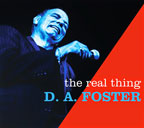 D.A.
Foster
D.A.
Foster
The Real Thing
Shaboo/Vizztone CD 001
Beginning as a teenager and all through his twenties, D.A. “Lefty”
Foster cut his teeth on the blues as a hands-on co-owner of the legendary
Shaboo Inn—a renowned R&B and jazz, 1000 seat nightclub in northeastern
Connecticut where he learned to sing the naturalistic, deep blues from
some of the greats (Howlin’ Wolf, Muddy Waters, John Lee Hooker,
Koko Taylor, Albert King and T-Bone Walker for starters), subsequently
forming his own band in 1979, the Shaboo All-Stars, with longtime buddy
and tough-as-nails guitarist Matt Murphy—who was fresh from his
starring role in the Blues Brothers movie and recording and James Cotton’s
band. They toured the country for the next two years and when the Shaboo
closed down in 1982, Foster and fabulous bassist Harvey Brooks began a
five-year run with the All-Stars, during which they opened for the likes
of B.B. King and Stevie Ray Vaughan. The versatile vocalist is joined
here by long-time pals (and co-producers) Mike Finnigan and Tony Braunagel
and their fabulous, Grammy award-winning Phantom Blues Band on twelve
of Foster’s favorite oldies. Highlights include reverberative versions
of a couple of latter-day Bobby “Blue” Bland classics (the
declarative “Ain’t Doin’ Too Bad” and an ultra-moody
ballad titled “This Time I’m Gone For Good”) as well
as soulful reincarnations of a pair of songs associated with Ray Charles—an
organ and tambourine embellished “I Need A Good Woman Bad”
and the reeling and rocking “Smack Dab In The Middle” that
sounds like 1956. Other drop-deaders are great recalls of both Z.Z. Hill’s
relaxing “Down Home Blues” and Eddie Hinton’s hips-wiggling
slice of braggadocio—”Super Lover.” Five stars!—Gary
von Tersch
 Cracking
The Cosimo Code
Cracking
The Cosimo Code
’60s New Orleans R&B And Soul
Ace CD TOP 1402
www.cosimocode.com
The recently unearthed Cosimo Code is an open-ended, website-based discographical
means (see above) of sequentially documenting the thousands of 1960s recordings
that emanated from the legendary Cosimo Matassa’s tiny pair of studios
in the Crescent City’s French Quarter. Compiled and featuring extensive
notes by Red Kelly, John Broven and John Ridley, this 24 track project
brings the Code’s numerical data to life by answering many of the
enigmatic questions that encircle most of the New Orleans-based R&B
and soul recordings from the post-Imperial Fats Domino era. A raft-full
of young producers on the order of Allen Toussaint, Mac Rebenack (Dr.
John), Harold Battiste, Huey Meaux and Wardell Quezergue were now “behind
the glass” and crafting music with a funkier, more soulful edge
to it while still employing the omnipresent New Orleans street rhythms—Jessie
Hill’s “Ooh Poo Pah Doo,” Robert Parker’s “Barefootin’,”
Aaron Neville’s “Tell It Like It Is,” Barbara Lynn’s
pop-charting “Second Fiddle Girl” and Lee Dorsey’s “Get
Out Of My Life, Woman” come readily to mind. All included here as
well as such regional hit gems as Earl King’s “Trick Bag,”
Oliver Morgan’s “Who Shot The La La” Eddie Bo’s
“Lover & A Friend” and Danny White’s “Kiss
Tomorrow Goodbye” and, best of all, plenty of superb rarities like
the cross-dressing Tick-Tocks with “I’m Gonna Get You Yet,”
Dave Bartholomew and his Orchestra’s bawdy “The Monkey Speaks
His Mind,” Huey “Piano” Smith emulators The Party Boys
with their wild “We Got A Party” (“Bring on the whiskey...I
can hardly stand up”) and Blazer Boy with his all-out rocker “New
Orleans Twist.” Amazingly, Cosimo had no competition in the 1960’s—thus
cracking the Code reveals a mirror image of the local recording scene
as it happened and as Kelly comments: “It wasn’t all R&B
and soul either—there was virtually every other genre of music,
including gospel, Cajun, rockabilly, country, psychedelic, garage rock
and trad jazz (even flamenco).” Sounds like we’ve got a lot
of great listening on tap!—Gary von Tersch
 Rev.
Payton’s Big Damn Band
Rev.
Payton’s Big Damn Band
So Delicious
Shanachie/Yazoo CD
Outside-the-box, country blues fingerstyle and slide guitarist and high-spirited
vocalist Rev. Peyton and his big-sounding band accomplices, composed of
his wife Breezy on exhilarating washboard and churning drummer Ben Russell
(both also lend supporting vocals to the proceedings), reestablish their
juke joint-noisy, genre-bending sound on their Yazoo debut—an ingenious
mix-up of vintage blues, ragtime and folk strains with dashes of country,
old-timey and an inordinate dollop of rustic, yet punk-edged, rock ‘n’
roll. As the Rev. puts it: “Yazoo was my favorite record label growing
up. For fans of old country blues and all manner of early American music,
they are the quintessential label. And for me, it’s like being on
the same label as Charley Patton and Mississippi John Hurt.” Compelling
picks among the eleven-song, all-originals set vary from somewhat restrained
contemplations like the autobiographical “Picking Paw Paws,”
an astute music business commentary “Scream In The Night”
and a resplendent “You’re Not Rich” to a resonator guitar
fulcrum-ed incantation “Raise A Little Hell,” the belly-full
post-repast “Pot Roast & Kisses” (written for Breezy),
a charging testimonial called “Music And Friends” and the
adventurous “Let’s Jump A Train.” Well worth the search!—Gary
von Tersch
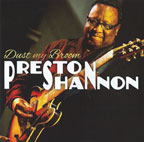 Preston
Shannon
Preston
Shannon
Dust My Broom
Continental Blue Heaven 2014
“The King of Beale Street,” Preston Shannon holds down a regular
biweekly gig at B.B. King’s Blues Club in Memphis. “Dust My
Broom” is a set of seven tracks comprising a tribute to slide guitar
great Elmore James, augmented by five more tracks with Shannon’s
sometime Dutch accompanying band, Fat Harry and the Fuzzy Licks, anchored
by noted bassist Henry Oden.
Tribute it may be, but only three of the songs are credited to Elmore
James in the liner notes. The album kicks off with one of them, “Done
Somebody Wrong.” Eschewing slide, Shannon instead provides zesty
single note guitar ventures along with his supple and slightly raspy baritone
vocal. Horns chime in (musicians unnamed), and the cut carves a template
for the rest of the album: soul-based blues reminiscent of another deceased
luminary, Little Milton Campbell.
Strangely, the second tune, “It Hurts Me Too,” is attributed
in the liner notes to Hound Dog Taylor, although most historians believe
James to have penned it. Regardless, Shannon deploys the slide and gives
it a laudable treatment, as he does with “Look Over Yonder Wall,”
which he modulates into a danceable near-shuffle.
Next we enjoy a diversion to the Muddy Waters tune, “Rollin’
and Tumblin’,” another horn-driven excursion that segues to
“The Sky Is Crying.” The latter is my favorite cut of the
album, sporting some beautiful guitar playing by Shannon and a style again
recalling Little Milton and even the old Paul Butterfield Blues Band’s
version of the classic “Double Trouble.”
“You Gotta Move” follows; this ostensible rendition of the
Reverend Gary Davis/Mississippi Fred McDowell original is unrecognizable,
but enjoyable on its own terms. The Elmore James tribute section concludes
with the inevitable “Dust My Broom,” once more adding some
Memphis spice to James’s classic version.
The final five songs, with the Dutch band, veer into soul and funk territory,
with some B.B. King-style guitar licks thrown in for piquancy, and the
set concludes with a long rendition of Prince’s “Purple Rain”
featuring Shannon’s crooning punctuated by his intermittent growls
and whoops. Overall, a worthy outing.— Steve Daniels
 Smokin’
Joe Kubek & Bnois King
Smokin’
Joe Kubek & Bnois King
Fat Man’s Shine Parlor
Blind Pig 2015
Returning to their previous record label after stints with Alligator and
Delta Groove, adept duo Kubek and King have produced another quality album
for Blind Pig that burnishes their quarter-century resume of musical partnership.
Having penned the entire dozen new songs, the duo demonstrates its virtuosity
with standard twelve-bar outings, shuffles, some Hendrix-style psychedelia,
and even a touch of heavy metal riffing while blues remains the foundation.
In contrast to their last album, which featured guests Kim Wilson and
Randy Chortkoff on harmonica and Kid Andersen on guitar, Kubek and King
rely on the solid rhythm section of Shiela Klinefelter on bass and Eric
Smith on drums. Actually, solid is an understatement: Klinefelter’s
four-string foundation is impeccable, and Smith’s drumming is a
revelation: unerring and inventive without ever being obtrusive.
“Got My Heart Broken” opens the set at a fast boogie pace,
followed by “Cornbread,” introduced by Kubek’s heavy
metal chording and featuring alternate guitar leads by the two principals.
The lyrical “Diamond Eyes” leads into two twelve-bar cuts,
“Crash and Burn” with its Allman Brothers-flavored opening
and “River of Whiskey,” a lament about the callow promiscuity
of youth. “Don’t Want to Be Alone” slows things down
and evokes memories of Peter Green’s guitar renderings with early
Fleetwood Mac, followed by “Brown Bomba Mojo,” a rocker with
Hendrix-influenced guitar pyrotechnics.
“How Much,” about the travails of touring, and “One
Girl by My Side” introduce humor into the mix, segueing into the
instrumental shuffle “Lone Star Lap Dance,” a vehicle for
both Kubek and King to display their impressive chops. The CD is capped
by “Done Caught the Blues,” a rueful reflection on being caught
cheating, and “Headed for Ruin,” a cautionary tale about the
pernicious appeal of distilled spirits.
Those who have seen Kubek and King perform live know that Kubek’s
undeniable skill on the ax is rivaled by King’s subtler and more
jazz-inflected solos. On this album, Kubek’s leads dominate, but
King’s ventures and the occasional interplay between the two guitars
add piquancy and variety. King handles all the vocal chores with aplomb
and panache, his supple tenor pleasing throughout. Kudos must also be
given to Smokin’ Joe’s production, and mastering by Joyride
Studios; the clarity of this recording is exemplary.— Steve Daniels
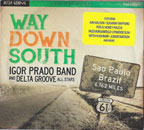 Igor
Prado Band and Delta Groove All-Stars
Igor
Prado Band and Delta Groove All-Stars
Way Down South
Delta Groove 2015
We know that music is the universal language, and that blues has had an
enthusiastic presence for many decades in Europe. Here’s more proof
from the Igor Prado Band that blues is alive and well in South America.
Guitarist Igor, his drummer brother Yuri, and their bandmates Rodrigo
Mantovani on bass, Denilson Martins on saxophone, and Ari Borger on piano
are all in their late 20s or early 30s, but have been a thriving and impressive
Brazilian blues band for at least a decade. Their collaboration with Lynwood
Slim (Richard Duran) on his 2010 album, “Brazilian Kicks,”
introduced them to a North American audience. “Way Down South”
is dedicated to Slim, who sadly died in 2014.
Recorded in Brazil at various sessions from 2012 to 2014, the album features
the band in collaboration with a series of star players from the roster
of Delta Groove Music. The baker’s dozen songs are all covers, and
span a range from West Coast jump style to gutbucket Chicago electric
grit to 1960s blues-soul ballad to spare acoustic country blues. Throughout,
the band acquits itself admirably while primarily giving support to the
guest luminaries. Igor in particular is relatively quiet, his adept guitar
chops only emerging on a few solos, particularly toward the end of “Rooster
Blues,” a version distinguished by the harmonica playing and singing
of Wallace Coleman. If anyone stands out from the band, it’s Borger
and his mastery of the 88s.
What a great list of guests appear! Up and coming blues vocalist Sugaray
Rayford lends his chops to “Big Mama Blues” and the opener,
“Matchbox”; Kim Wilson (overdubbed on his vocal two tracks)
sounds as smooth as ever.
Mud Morganfield does his daddy Muddy Waters proud on Muddy’s “She’s
Got It,” one of my favorite tunes on the CD, and the silky vocals
of Lynwood Slim on “You Better Believe It” and the rollicking
“Baby Won’t You Jump with Me” remind us of how we miss
him. Mitch Kashmar lends his underrated singing and jazz-inflected harmonica
artistry to “What Have I Done.” Wallace and Omar Coleman handle
one vocal each. Last but not least, the conjugal duo of Rod Piazza on
vocal and harp and spouse Honey on piano lives up to Rod’s intro
on “Talk to Me Baby”: “We gonna cut this sucker, baby;
we got all the powers now.” Enlivened by a stellar solo by Igor,
they deliver on Rod’s promise.
My only quibbles: the liner notes don’t identify who plays which
solos on the two tracks in which Igor shares guitar duties with Mike Welch
and then Junior Watson; and the band stays too far in the background while
letting its guests shine. Igor’s vocals are competent, although
less impressive than those of his guests, but it’s time to let this
band loose on an album all its own; the band can easily thrive on its
own merits.— Steve Daniels
 Lucky
3 Blues Band
Lucky
3 Blues Band
Blues Time
Lucky 3 Records
www.lucky3bluesband.com
With the advent of young stripped down blues rock bands on the scene these
old school Chicago players of the Lucky 3 Blues Band are taking contemporary
blues in a modern direction and you the listener is hitting the jack pot.
This bare bones trio of Jay O’Rourke playing guitar, Frank Raven
blowing harp and Jim Desmond kicking out the vocals were bitten by the
blues bug at an early age and spent years working the Monday Jams at Buddy
Guy’s and blowing alongside Jerry Portnoy and Carey Bell. Now they’re
itching to play their own blues. With O’Rourke’s early years
as a sound engineer in Techno music he brought in drum machines without
losing a true blues feeling. I listened to it several times before I realized
it was just 3 guys on harp, guitar and vocal instead of a full band. Their
self-released CD “Blues Time,” a five song EP with a raw edged
intensity is twenty minutes of pure blues thrills.
With every song having the word blues in the title they’ve jump
started the disc with Raven taking the lead on harp as Desmond declares
it’s “Blues Time” baby and pushing ahead with Jay’s
dirty guitar licks overtaking the rolling harmonica they’ve got
the “Blues On the Run” and there ain’t no need to call
911. An assault of wailing guitar, boisterous vocals and howling harmonica
the Lucky 3 deliver their own take on “Evil” with “Blues
Don’t Live Here Anymore.” Bringing down the tempo, the haunting
guitar licks and wavering harmonica has Desmond attesting to the fact
that the “Blues Will Never Leave You.” Closing out with a
determined force they explode across the groove to give you the “Blues
You Can Use” over the harp refrain of Sonny Boy’s “Help
Me.”
If you’re willing to take a chance on an innovative band with deep
blues roots the Lucky 3 Blues Band’s new CD “Blues Time”
may be your bonanza of blues.—Roger & Margaret Whitebluestime@sbcglobal.net
 Madison
Slim
Madison
Slim
Close...But No Cigar
All About Blues, INC slimcigar@yahoo.com
Madison Slim is the man who played with Muddy Waters, Jimmy Rogers, Sam
Lay and was the legendary harp in The Legendary Blues Bands. After years
of touring Slim decided to bid farewell to the road to reflect on the
Florida gulf coast sunsets and thought he’d closed the book on his
blues career. But when he met fellow Bradenton Florida resident Doug Deming
he found a like-minded soul and a whole new chapter opened before him.
His retirement has become enjoying the beach, blowing harp with Doug Deming
& The Jewel Tones and sitting in with touring friends like Bob Margolin.
Now Slim is back in the studio with some of the hottest players in the
land, The Jewel Tones, fellow Florida resident Terry Hanck on sax with
Chicago’s Billy Flynn and Barrelhouse Chuck on guitar and piano
with Doug producing “Close...But No Cigar.”
Pumping out a sound as genuine as you’ll find anywhere in Chicago
over the last fifty years, the harp moans in Eddie Taylor’s “Big
Town Playboy” with Slim’s age-mellowed voice hitting the sweet
spots then takes a tough stance for Slim Harpo’s “Bread Maker
Baby” where Slim’s reeds have a metallic ring. For Billy Boy
Arnold’s “Kissing At Midnight” the guitars are channeling
Magic Sam while on Willie Mabon’s “Would You Baby” Slim
lays out his slickest jive with Chuck and Terry tearing it up. Madison
takes complete possession of Muddy’s “I Got to Find My Baby”
and you believe his call of “I need a hundred dollars” on
Floyd Jones “Stockyard Blues,” because Slim is retired. Doing
a pair of Jimmy tunes, Reed’s “New Leaf” is a rockin’
high harp blow out, then mellows on Rogers “If It Ain’t Me”
as Chuck rolls one and hits his stride on Domino’s “Let The
Four Winds Blow” as Slim’s vocals take a leisurely stroll.
Some of the best rockers are Eddie Bond’s “Blue Coat Man”
where Barrelhouse Chuck flaunts his chops under Slim’s restrained
verses then Tarheel Slim’s “Wild Cat Tamer” is driven
by a staccato piano as Billy’s guitar whips it hard and fast. “Close
But No Cigar” has an easy loping stride similar to Memphis-era Wolf
shadowing Hubert on guitar. The only tune Slim has penned is “Florida
Blues,” they say it’s a slow life down there and Slim blows
the instrumental cool and mellow.
With a title of “Close....But No Cigar,” all I’ll tell
Madison Slim is, no cigar? Damn I’d swear this blues was smoking!—Roger
& Margaret White bluestime@sbcglobal.net
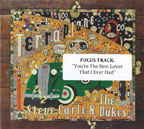 Steve
Earle & The Dukes
Steve
Earle & The Dukes
Terraplane
New West Records 2015
Widely acknowledged as a seminal genre of American music, the blues has
drawn tribute forays from such diverse artists as Cyndi Lauper, Tom Petty,
and the actors Hugh Laurie and Bruce Willis among many others. Such outings
often elicit the perennial question, ‘Is it the blues?’ Many
of us, including respected musicians, reply either: ‘It’s
all music’; ‘labels are meaningless’ or, ‘If it
has a blues sensibility, it doesn’t have to fit a 12-bar format
to be the blues.’
Renowned Grammy winner and respected country rocker Steve Earle now takes
his turn, announcing in this album’s liner notes that he always
knew “that one day, when it was time, I would make this record,”
i.e., a blues record! In crafting all eleven songs, Earle deploys the
literary skills which have distinguished his many past efforts, including
not only songs but a previous novel. Check out these lyrics:
“I’m the king of the Blues thirteenth of the line
The first of my name and the last of my kind
One foot in the grave and one hand
On the handle of time
Descended directly from St. John the Conqueroo
And the king of the blues.”
The album is replete with wry, erotic, and soulful lyrics, which progressively
improve after the most forgettable track, the opener, “Baby Baby
Baby (Baby),” in which that one word appears more than 60 times
and constitutes almost 50% of the verbiage.
The question remains, though, is this a blues album? Well, I concede that
there are actually three or four indisputable blues tunes. “The
Usual Time” is a Jimmy Reed/Slim Harpo-style shuffle, abetted by
Earle’s competent harmonica renderings. The brief “Acquainted
with the Wind” is a mid-tempo boogie that sounds remarkably like
John Lee Hooker’s “Boom Boom Boom,” and “King
of the Blues” is a slow track with distorted guitar evoking Jimi
Hendrix and Neil Young, and sporting the intriguing lyrics sampled above.
One of my favorite tracks is the penultimate, “Gamblin’ Blues,”
a no-frills ditty which skirts the border between country blues and simply
country, and is distinguished by some tasteful acoustic guitar.
The remainder of the cuts are pure country or country rock…pleasing
and adept, for the most part. Especially effective is “The Tennessee
Kid,” a mesmerizing slow talking tale of an encounter between the
Kid and “Lucifer, Satan, Mephistopheles, and Beelzebub” that
evokes Robert Johnson’s apocryphal meeting with said devil at the
crossroads and is certainly “bluesy” in sensibility. Earle
really nails it on this one, making excellent use of his raspy tenor vocal.
In sum: thanks, Mr. Earle, for tipping your hat to the blues; I like a
lot of it; now go back to what you do best.— Steve Daniels
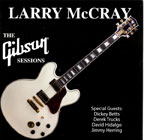 Larry
McCray
Larry
McCray
The Gibson Sessions
Nine albums into his career Larry McCray has taken a bit of a detour.
The scenario is usually one of a rocker wanting to give props to his blues
roots, not the other way around. McCray is a first class blues man who
came up like a lot of folks — listening to rock radio and playing
along with the hit makers of the day. The key to covering an artist’s
music is to reinvent it and make it your own. McCray understands this
perfectly and puts his own stamp on an even dozen classic radio rockers
from Lynyrd Skynyrd, Bob Seger, ZZ Top, the Marshall Tucker Band, the
Doobie Brothers, Billy Preston, Ray Charles, Uriah Heep, the Rolling Stones,
and Creedence Clearwater Revival. Blues purists may have difficulty swallowing
that set list. McCray fans, those with an appreciation for his monster
chops, will be on board.
Does everything here work? No. But most of this is a load of fun. Backed
by his regular band of Steve McCray (drums), Noel Neal (bass), and Johnny
Neel (keyboards), the presence of a few guest stars sweetens the pot.
On the opener, Needle and the Spoon, Derek Trucks trades licks with McCray
and the results are electrifying. An anti-heroin song from 40 years ago,
it’s still relevant and, where Lynyrd Skynyrd used a three guitar
front line, McCray and Trucks do it with two. His version of Waiting for
the Bus is clever for taking Billy Gibbons’ signature guitar sound
and adding his own burn. Definitely one of the standout numbers.
I’m No Angel, a standard Gregg Allman vehicle, sees McCray joined
by David Hidalgo of Los Lobos to impressive effect. Dickie Betts shares
the stage with McCray on a fiery take of the Marshall Tucker Band’s
Can’t You See. Betts is one of the greats in blues rock and his
interplay with McCray is stellar. Both guitarists are in extraordinary
form. Also of note is McCray’s version of Born On the Bayou. One
would think that the Creedence version was untouchable, but McCray gives
it his own twist. The result is more than impressive. The same can be
said about these rockin’ rollin’ Gibson Sessions.—Mark
Gallo
 Bernard
Allison Group
Bernard
Allison Group
In The Mix
Jazzhaus CD 106 www.jazzhouserecords.com
Breezy Rodio
So Close To It
Windchill CD 1001 www.breezyrodio.com
Iconic blues guitarist and vocalist Bernard Allison’s first new
studio album in nearly six years was certainly worth the wait. Released
on Germany’s esteemed Jazzhaus label and produced and arranged by
the talented Allison, it features ten bluesily soulful (with a jigger-full
of R&B) tracks including five nifty, cliche-free Allison originals
(picks are the pensive story-song “Tell Me Mama” and a Hammond
B-3 buttressed plea titled “Set Me Free”) as well as covers
of a pair of tunes long associated with his father, Windy City blues legend
Luther Allison—a sax-reinforced, totally contemporary advisory called
“Move From The Hood” and the even more poignant “Moving
On Up.” A trio of other reprises by Allison round things out—Colin
James’ “Five Long Years” struts and soars in a take-no-prisoners
fashion while Freddy King’s carnally atmospheric “I’d
Rather Be Blind” is rhythmically riveting (while also containing
some of Allison’s most scintillating guitar work) and, best for
last, Tyrone Davis’ timeless “I Had It All The Time.”
Worth the search! Likewise, So Close To It by oddly moniker-ed singer/songwriter
and astonishingly accomplished guitarist Breezy Rodio, whose breezy blues
odyssey stretches from a New York boyhood to the current, exceedingly
competitive, Chicago club circuit. After a brief association with Guy
King, Rodio joined veteran Linsey ‘Hoochie Man” Alexander’s
band, on stage and in the studio, impressing Delmark’s head honcho,
Bob Koester, in the process and leading to this Delmark 15 track project—one
of which is a “bonus” recall of one of Bo Carter’s touchstone
numbers—a slowly pulsing complaint about his “Evil Hearted
Woman.” More than half of the songs are Rodio originals—favorites
include a tough “walking blues,” titled “Walking With
My Baby (She So Fine)” that features Billy Branch on harmonica,
a thoughtful, T-Bone Walker-influenced “I Win Some More” (with
Lurrie Bell guesting on second guitar) and the tempo-shifting entreaty
“Time To Come Back Home”—with Chris Foreman and “Ariyo”
Sumito Ariyoshi joining in on organ and piano respectively. Also noted
are buoyant covers of Otis Blackwell’s soulful “One Broken
Heart For Sale” and Sonny Boy Williamson’s naturalistic “When
My Heart Beats Like A Hammer.” As liners author Bill Dahl puts it:
“Judging from the convincing contents of this set, this sure won’t
be Breezy’s last rodeo!—Gary von Tersch
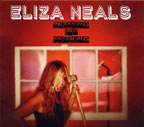 Eliza
Neals
Eliza
Neals
Breaking And Entering
BluesRock
e-hrecords.com www.elizaneals.com
She’s been burning up stages and winning awards in Detroit for years
and with “Breaking and Entering” Eliza Neals is busting onto
the national scene with a vengeance. Her band of long time Motor City
warriors featuring power house blues guitarist Howard Glazer, P-Funk drummer
Gabe Gonzales and internationally renowned bassist Paul Randolph filling
out the grooves of Eliza’s vocals and keyboards. Neals has taken
charge, co-producing and co-writing most of the songs and enlisting winning
hip hip producer and guitarist Mike Puwal, Kid Rock’s guitarist
Kenny Olson and Motown’s Barrett Strong to complete her team. Though
a complete Motor City aggregation they haven’t stayed at home, recording
in Nashville and New Jersey as well as Detroit and running release parties
from New York to Miami. This girl is ready to do some crimes.
Starting with a Dobro and foot stomping beat “Detroit Drive”
is a contradiction to an urban cruise but “Breaking and Entering”
intrudes with a harder edge. Neals’ tough gritty vocal bring to
mind fellow Detroiter Shawn Murphy and the guitar is just as tough &
dirty. “Pretty Gritty” is powered by Eliza’s piano,
hand clapping rhythms and is super charged by her vocals and stinging
guitar. “Sugar Daddy” is a song written for Neals by Motown’s
Barret Strong and you can hear the echoes of his past hits as her piano
charges into “I’m The Girl.” Slowing the pace and losing
the grit for several ballads “Jekyll and A Hound” Puwal has
a stinging slide that echoes George Harrison while Kenny Olson is featured
on the power ballads “You” and “Southern Comfort Dreams.”
Some stand out cuts feature both soft and brash sides of Eliza against
Glazer’s guitar, “Windshield Wipers” are “wiping
my tears away,” her piano tinkling like raindrops while slashes
of guitar flash like thunder and lightning as her voice builds in fury
while “Spinning” is just her powerhouse vocals, heavily distorted
Hendrix-y guitar and hand claps. As an added feature a shortened radio
edit of “Breaking and Entering” is included.
Eliza Neals is breaking down musical doors with her CD “Breaking
and Entering,” but it’s only a crime if you don’t give
it a listen.—Roger & Margaret White bluestime@sbcglobal.net
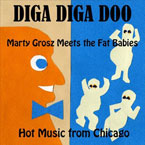 Marty
Grosz Meets The Fat Babies
Marty
Grosz Meets The Fat Babies
Diga Diga Doo
Delmark CD DE-256 www.delmark.com
This thoroughly entertaining 19 tracker is sub-titled “Hot Music
From Chicago” and that’s certainly no understatement as legendary
octogenarian East Coast jazz rhythm guitarist and deft single-chord soloist
Marty Grosz returns to Delmark’s fabled Riverside Studio accompanied
in fine fashion by string bassist Beau Samples and his dynamic young hot
jazz outfit, the seven-piece Fat Babies, who pack the dance floor regularly
at the illustrious Green Mill—as well as special guests such
as Ann Arbor-based pianist Jim Dapogny, Philly-based trombonist
Panic Slim and former Chicagoan roots clarinet and tenor sax star Jonathan
Doyle. While the engaging Fat Babies energetically convey penetratingly
infectious and historically aware interpretations of the vintage (mostly
from the 1920’s and 1930’s) traditional jazz material, the
still nimble-fingered Grosz—the last remaining exponent of the acoustic
guitar in jazz, whose solos recall the 1930’s fortified sound of
Carl Kress and Dick McDonough—is as “on the beam” as
ever. Not to mention his invigorating Fats Waller-like vocals on the standards
“Sweet Sue” and “Rose Of Washington Square.” Other
dance floor favorites are “Strut Miss Lizzie,” the opening
stomper “Why Couldn’t It Be Poor Little Me” and the
blue-blowing-studded title tune, from Duke Ellington’s songbook,
with Fat Baby Andy Schumm on comb and newsprint. Barrelhouse blues at
its best. Grosz is also one of jazz music’s outstanding monologists—check
out the last two tracks.—Gary von Tersch
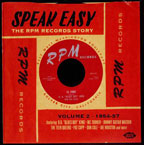 Speak
Easy:
Speak
Easy:
The RPM Record Story
Volume Two—
1954-1957
Ace CDTOP2 1421
www.acerecords.co.uk
This pretty prompt follow-up to Ace’s RPM RECORD STORY—VOLUME
1 (1950-1953) is just as rewarding as compiler, liners author (20 pages)
and archival researcher Tony Rounce trawls though yet another hundred
or so RPM jukebox singles that were issued before it was all over by 1958.
54 tracks on a pair of CDs (many previously unissued or un-reissued performances
and all remastered from fresh sources) range from plenty of urban down-home
blues by the good-selling likes of favorites like B.B. King (lots of B.B.
King), Ike Turner (under the alias “Lover Boy”), the often
under-recognized harmonica ace “Little George” Smith (way
before Bacon Fat), honking saxist Joe Houston and the young Johnny “Guitar”
Watson to the more obscure likes of Eugene Fox (his outrageous two-parter
“The Dream” is here), Lonnie “The Cat” Cation
(with his great “I Ain’t Drunk”), Johnny Wright, Eddy
Lang and Darrell Glenn & The Commodores with a bluesily soulful, Jerry
Lee Lewis-inspired “Hello Baby,” as well as a few rockabilly
outings by Pat Cupp (Joe Bihari’s answer to Elvis), a smattering
of group sounds from the West Coast’s Teen Queens, the Jacks, Arthur
Lee Maye & The Crowns, the Chanters (their hypnotic “She Wants
To Mambo” is here), the Meadow Larks and Little Clydie & The
Teens, a little pop from Paul Anka, B.B. King (an awful cover of Ernie
Ford’s “16 Tons”), the Jewels and white rock ‘n’
roller Don Cole and further fine saxophony by the likes of Maxwell Davis
and Vido Musso. Also dropping by, with across-the-board, stellar sides,
are vibrant thrush Donna Hightower, Quinton Kimble, Rosco Gordon-influenced
Earl Curry, Jack Lewis and Eddy Lang among others. Ace also has a host
of single artist compilations by many RPM acts in its catalog. Very recommended.—Gary
von Tersch
 Danielle
Nicole
Danielle
Nicole
Danielle Nicole
Concord CD
www.concordmusicgroup.com
Don’t miss this one. Comprising only six songs, this self-titled
EP only whets ones ear-lobes for more of the stunning New Orleans-flavored,
funky soul-blues-roots brew that the ex-Trampled Under Foot singer/bassist
and songwriter displays here on her debut solo outing. The first four
tracks were recorded in the Crescent City with Grammy-winning Anders Osborne
producing and adding some intrepid guitar work to affairs accompanied
forthrightly by Galactic’s co-founding drummer Stanton Moore and
her regular keyboardist Mike “Shinetop, Jr.” Sedovic. The
last two tracks, on the other hand, were recorded live at Kansas City’s
Triple A radio station studio (KTBG—The Bridge—90.9 FM) with
Nicole singing and playing acoustic guitar on stripped down, confidential
versions of both her lovelorn epic “You Only Need Me When You’re
Down” and Bob Dylan’s classic rambling-on song “Don’t
Think Twice, It’s Alright.” Picks from the Osborne-involved
numbers are a lead-off “band” version of “You Only Need
Me” and the breezily contemplative “Wandering Heart,”
where Nicole digs down deep. A formidable solo artist, who made her stage
debut at the age of twelve singing Koko Taylor’s “Never Trust
A Man” at a Blues for Schools program, is born. Worth the search.—Gary
von Tersch
 Jackie
DeShannon
Jackie
DeShannon
In The Wind/Are You Ready For This?/New Image/What The World Needs Now
Is Love
BGO CD 1176
www.bgo-records.com
Pioneering female singer/songwriter Jackie DeShannon’s rock ‘n’
roll credentials go all the way back to 1957 when a sixteen year old Sharon
Lee Meyers sang a couple of rockabilly songs as part of Alan Freed’s
Big Rock ‘n’ Roll Show at New York City’s fabled Paramount
Theater. Her big break came in 1964 when she supported the Beatles on
their initial U.S. tour, formed a touring band with Ry Cooder and began
penning songs for the likes of the Byrds and Marianne Faithfull as well
in partnership with Jimmy Page and Randy Newman. These four album reissues
span the years 1965-1968 and reflect the times with In The Wind featuring
somewhat over-produced pop-folk arrangements of contemporary (Bob Dylan,
Bobby Darin, Pete Seeger) and traditional material. 1966’s Are You
Ready For This? adds a Diana Ross/Dionne Warwick smooth soul veneer
to affairs (with great recalls of “Will You Love Me Tomorrow”
and “You Don’t Have To Say You Love Me” among others)
while 1967’s New Image veers drastically into easy listening territory
with a surfeit of covers—though I am fond of her versions of “A
Sunday Kind Of Love” and Cole Porter’s “Night And Day.”
Finally, 1968’s What The World Needs Now Is Love (a Top Ten hit
for her in 1965) has a mellow West Coast sunshine-pop sound to it with
catchy reprises of songs like “It’s All In The Game,”
“Everything Under The Sun” and “Call Me” leading
the way. And it all comes back to the Beatles—73 year old DeShannon
is currently an entertainment broadcast correspondent for Sirius XM Satellite
Radio’s Breakfast With The Beatles weekend show. Recommended.—Gary
von Tersch
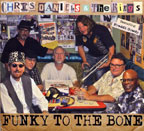 Chris
Daniels & the Kings
Chris
Daniels & the Kings
featuring Freddi Gowdy
Funky To The Bone
www.chrisdaniels.com
Chris Daniels & the Kings, the emperors of funk in the Rocky Mountain
high of Colorado are a fusion somewhere between Ohio Players and KC &
The Sunshine Band or the ying and yang of this nation under a groove.
These grand masters of Funk ’n Roll were the Sam & Dave meets
Tower of Power in their 1980’s prime. Recently band leader Chris
Daniels and vocalist Freddi Gowdy have both overcome serious illness and
realizing they’d been given a second chance, have reassembled the
band and are now ready to get “Funky To The Bone.” The Kings
are the complete retro Soul package, the band is kicking with full horn
section, back up singers, even the CD looks like vinyl and the booklet
uses classic magazine covers. The current Kings are Chris Daniels vocals
& guitar, “Bones” Jones on lead guitar, “Bro”
Lee, bass, Randy Amen, drums,“Doody” Abrahamson, trumpet,
Jim Waddell, alto, tenor sax, flute with Bill Paine of Little Feat on
keys and Freddi Gowdy getting with the get down.
Jumping in with a strong groove “Funky To The Bone” has a
James Gang guitar hook, JB horns, Brides of Funkenstien choir as Freddi
gets down deep followed by the P-Funk-esque romp of “Don’t
Let Your Mouth Write No Checks.” Daniels leads the band through
the classic Chris Kenner hit “Something You Got” then blows
through with a lighter summer-fresh “Cool Breeze.” Getting
it on with the rock & soul music of “Dance Dance Dance”
Paine’s fleet fingered organ and the horn lines lead to the strong
strut and dueling vocals of “What A Day.” The horns are the
heroes of the salsa soul venture “Nobody Knows” and they finish
with their own story of “Survivors.”
With their new lease on life, Chris Daniels & the Kings prepare for
a European tour and their new CD “Funky To The Bone” may be
their ticket to ride.—Roger & Margaret White bluestime@sbcglobal.net
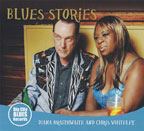 Diana
Braithwaite and Chris Whiteley
Diana
Braithwaite and Chris Whiteley
Blues Stories
Big City Blues Records 2014
Little known in the U.S., Diana Braithwaite and Chris Whiteley are mainstays
of the Canadian blues scene. Whiteley is a multi-instrumentalist and Braithwaite
a vocalist, and separately and together they have won nine Maple Blues
Awards and garnered even more nominations. In this, their sixth album
together, they have produced a potpourri of six originals and five covers
which sample a gamut of blues sub-genres.
The CD kicks off with “Rocks and Gravel,” an a cappella call-and-response
featuring Diana and Kala Braithwaite which pays tribute to the field holler
and work song provenance of the blues. Its somber tone is followed by
the rollicking, infectious “Florida,” a boogie that would
have done John Lee Hooker proud. Whiteley next deploys slide guitar on
“Lighthouse Keeper,” abetted by bandmates Vince Maccarone
on drums and Terry Wilkins on bass. “Bye Bye Bird,” a tune
by Willie Dixon and Sonny Boy Williamson, then provides a jaunty country
flavor as Braithwaite sings in front of Whiteley’s spare harmonica
accompaniment, and it’s succeeded by “Blues March,”
a New Orleans-based full band outing highlighted by Chris’s cornet
renderings and the piano stylings of Jesse Whiteley.
What do we get next for even more variety? Well, “Fried Fish,”
a mid-tempo 12-bar blues rocker with the two principals vocally harmonizing
nicely while touting the virtues of the aquatic delicacy paired with rum
and ginger ale. That the song, purportedly written by Braithwaite and
Whiteley, sounds much like standard blues tunes “Good Rockin’
Tonight” and “Blue Light Boogie,” is a minor cavil.
“Child of Circumstance” is the longest track, a slow blues
which overcomes some awkward lyrics and especially showcases Jesse Whiteley’s
prowess on the keys and Chris’s on mouth harp. “Tic Tac”
again lets Jesse lay down some nice riffs, in a song reminiscent of Marvin
Gaye’s “Hitch Hike” from 1962. “Hard Time Killin’
Floor” can’t match the haunting vocal of its originator “Skip”
James (no version ever will), but is still effective in its spare vocal-and-acoustic
guitar presentation. The traditional tune “Careless Love”
is given a nice Crescent City lilt, Chris demonstrating why he has won
awards for his cornet skills. The album closes with a version of Jimmy
Reed’s “You Don’t Have to Go,” the thumping rhythm
tempered by Chris’s harmonica fluidity.— Steve Daniels
BOOKS
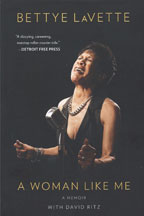 Bettye
LaVette
Bettye
LaVette
A Woman Like Me: A Memoir
By Bettye LaVette with David Ritz
Plume 2012
Teachers of short story writing advise authors to produce a compelling
first sentence, or the reader’s full attention may be lost forever.
Well, Bettye LaVette has met the challenge: “A vicious pimp was
precariously holding on to my right foot as he dangled me from the top
of a twenty-story building….”
She has survived, in more ways than one. LaVette’s autobiography
is a ferocious, uncompromising, alternately revelatory and hilarious roller-coaster
ride through her first seven decades of life. In it she chronicles her
long journey from tumultuous childhood to teenage motherhood, her pre-adult
years as soul singer/groupie/prostitute, and her subsequent decades of
struggle as a songstress in bars, nightclubs, private parties, and local
touring stage troupes…to her current status as highly acclaimed
soul and blues artist. It’s a jaw-dropping journey. Her lust for
success and recognition burns through these pages.
Several themes resonate in her story, including sex, drugs, alcohol, sexism,
friendship, religion (lack thereof), and luck, both good and bad. At no
point is LaVette rueful about the many impulsive and unwise decisions
that she made, although she also spares no bile in skewering those —
and they were legion, according to her — who mistreated, underestimated,
or betrayed her. As she explains, “Music’s simply something
I do, something I am, a restless force that, if it’s not brought
out, will drive me crazy.” In pursuit of her muse, she left her
daughter to be raised by others, accepted gigs beneath her worth, and
peregrinated from Detroit to New York, New Orleans, Houston, Los Angeles,
and myriad other venues in search of the grail of success.
Along the way, she had to deal with the rampant sexism prevalent in the
American music industry and, arguably, in American culture. “My
instinct was to survive as a singer and prevail as a person. It didn’t
take a genius to realize that men held the key to that survival….Women
were their props.” Fortunately for LaVette, since her eagerly accepted
deflowering at age twelve, she has not only accepted but enjoyed sex and
lots of it, and taken as much as she has given. Her list of lovers, including
several valued musical mentors, is dizzyingly long, featuring some famous
names you will recognize. (Currently she seems blissfully happy with her
third husband.)
The scion of alcoholic parents, LaVette is refreshingly honest and unapologetic
about her own substantial dipsomania and marijuana use, and her several
decade intimate familiarity with cocaine: “My drive to succeed has
not been stymied by my fondness for intoxicants.” (She claims always
to have eschewed heroin and crack cocaine.)
Her drive to succeed was, though, by her account, frustrated over and
over again by deceitful or risk-averse record companies. (“Risk-averse”
is not a term applicable to LaVette’s life choices.) Of course,
a self-penned memoir may see only one side of the street, even in retrospect;
it’s hard to know if record labels’ alleged repeated desertions
of LaVette were at least partially attributable to her admittedly uncompromising
and “bitchy” personality. Surprisingly, she has little to
say about racism, both in the music industry and how it pertained to her
specifically, perhaps because either by choice or circumstance she remained
ensconced primarily in black cultural circles. It would be fascinating
to hear some cited music executives give their perspectives on why she
never became a star on their labels.
There is a lot to admire about Bettye LaVette, aside from her terrific
singing talent. I did cringe near the end of the book when she described
a gift from her current husband during their courting: “…an
exquisitely custom-designed multi-CD package of my complete recorded work….It
was the most precious and loving gift I have ever received.” Really?
Doesn’t that reveal a monstrous ego? However, she redeems herself
with many kind words of gratitude for her past lovers, supporters, and
musical mentors, especially Jim Lewis, who fit all three categories and
who taught her to sing in varied styles. “ ‘You caress a song,’
he said, “you don’t attack it. You relax and let the song
come to you. You dramatize the story like a great actress….You take
your time.’ “ She learned her lessons well.
It took a long time for Bettye LaVette to make it big, but she did, and
it has made her happy. We get to enjoy her music, and now also her memoir,
which is simultaneously outrageous, entertaining, and moving.— Steve
Daniels
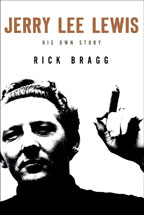 Jerry
Lee Lewis: His Own Story
Jerry
Lee Lewis: His Own Story
by Rick Bragg
Canongate Books www.canongate.tv
One of rock ‘n’ rolls great icons, the force of nature known
as Jerry Lee Lewis was born in Ferriday, Louisiana in 1935 and will be
celebrating his 80th birthday this September. As this fascinating authorized
biography (Bragg had unprecedented access to “The Killer”)
engagingly recounts, Lewis had a fully developed, two-handed style all
his own before he was a teenager—heavily influenced by Country &
Western radio shows (he idolized Hank Williams) and the blues pouring
out of the local juke joints that he used to sneak into, although his
attacking, piano-stool kicking style of piano playing owes a lot to Texas
honky-tonk pianist Moon Mullican. Mesmerically, Bragg relates a childhood
raising all kinds of hell in Louisiana and Mississippi, his lengthy career
at Sun Records (where he broke nationally in 1957 with his second and
third singles, “Whole Lotta Shakin’ Going On” and “Great
Balls Of Fire”), performing with everyone from Elvis Presley, Buddy
Holly and Little Richard to Mick Jagger, Bruce Springsteen and Buddy Guy,
caused riots and boycotts with his swaggeringly primitive performances
(some of the most entertaining recollections), nearly destroyed his career
by marrying his 13-year-old cousin, the third of his seven wives, survived
a decades-long marathon of drugs, drinking and women and nearly died at
least three times. Yet, he survived it all to be celebrated as not only
a rock and roll innovator but a country and western star. Throughout,
Lewis’, lifelong and still unrepentant outrageousness makes this
book stay-up-all-night reading. Devotees are also apprised that London’s
BGO label (www.bgo-records.com) has recently reissued many of Lewis’
country albums as budget two-fers. The most recent showcases two of his
best—1972’s Who’s Gonna Play This Old Piano...(Think
About It Darlin’), whose reflective title song would remain in his
repertoire for years, and 1973’s Sometimes A Memory Ain’t
Enough, that features great versions of both the Sun-era classic “I’m
Left, You’re Right, She’s Gone” and Billy Joe Shavers’
“Ride Me Down Easy.” And, lo and behold, Vanguard has just
issued a new Lewis studio album, titled Rock & Roll Time, and that
is a good description. The Killer, with guests like Keith Richards, Neil
Young and Ivan Neville, sounds a little unduly laid-back at times (who
could blame him?) but certainly sets the record straight on a couple of
Chuck Berry reeling and rockers—”Little Queenie” and
“Promised Land.” Lewis is also currently on tour in the UK.
Holy moly!—Gary von Tersch
FILM
 Cheesehead
Blues
Cheesehead
Blues
Adventures of a Dutchman in the Mississippi Delta
A Film by Jan Doense.
Film Events 2015 www.filmevents.nl www.blues2rock.com
Many blues aficionados who have been to the Mississippi Delta town of
Clarksdale have visited the Rock-n-Blues Museum on Second Street downtown.
The owner, Theo Dasbach was living in his home country of Holland, and
running a small museum there exhibiting his extensive collection of blues
& R&B records and memorabilia. By 2006 this Dutchman was living
& running the museum in Clarksdale. In 2009 another Dutchman, Jan
Doense came to Clarksdale and was astonished to find Theo living there.
In 2011 he returned to make a film that depicted Theo’s life in
the Delta.
Cheesehead Blues is referenced to a “Kaaskop” or “Cheesehead,”
the nickname given to a Dutch person. Dutch filmmaker Doense has captured
the essence of the city as well as interviewing many of the town’s
famous faces. The gritty streets of Clarksdale are well reflected as a
proper backdrop to the film. Theo’s life abroad is revealed as he
made his way to America and into the mid-south heartland, The land of
the blues, Memphis. After buying property in Clarksdale he opened his
museum. Jammed full of great exhibits and his vast 78 rpm collection that
travels through time from early Ma Rainey & Bessie Smith through the
Post-War Blues and beyond.
Doense also interviewed many of the town folk who are famous on the blues
trail including Mayor Bill Luckett, the late T-Model Ford, Roger Stolle,
the late Frank “Rat” Ratliff and “Big” Red Paden,
who incidentally reveals some interesting information about his family
tree. Theo has also produced his 2nd Street Blues Party for several years
now and Doense was there to film the music. Several live performances
are included in the film including full length performances of the soundtrack
in a special feature section of the DVD. Some of the musicians featured
in the film include among others, Terry “Harmonica” Bean,
Watermelon Slim, Sean “Bad” Apple, Deak Harp, Bill “Howl-n-Madd”
Perry, T-Model Ford, Laura “LaLa” Craig and the late Charlie
Moore.
The film is really about keeping the blues alive & well in Clarksdale
with the help of local musicians and blues lovers like Theo, who goes
by Theo “Boogieman” Dasbach when he’s playing his piano.
When it comes to the aspect of a film documentary, Cheesehead Blues holds
its own. Quite entertaining in its content and besides revealing Theo’s
life in this small Delta town, the film also tosses in subtle hints of
Clarksdale’s blues history. If you are a fan of Clarksdale and have
visited the city then you’ll want to see this film. For those of
us who have lived here for sometime, the film gives us even more. Lots
of great friends, great music and great memories. — Dirk Wissbaum
Home
/ Blues Blogs /
Artist Links / Blues
Links / Videos / Store
Subscribe / Advertise
/ Back Issues
/ Contact / Staff